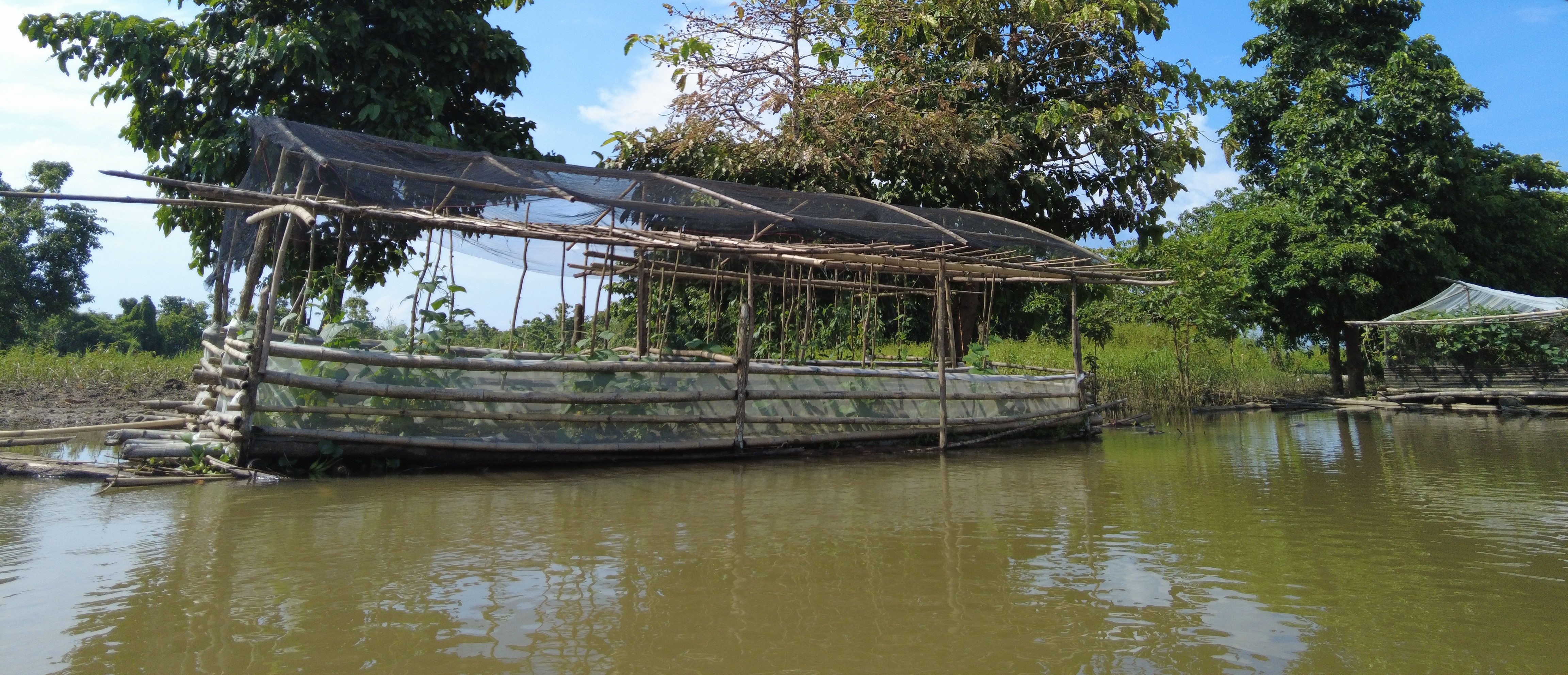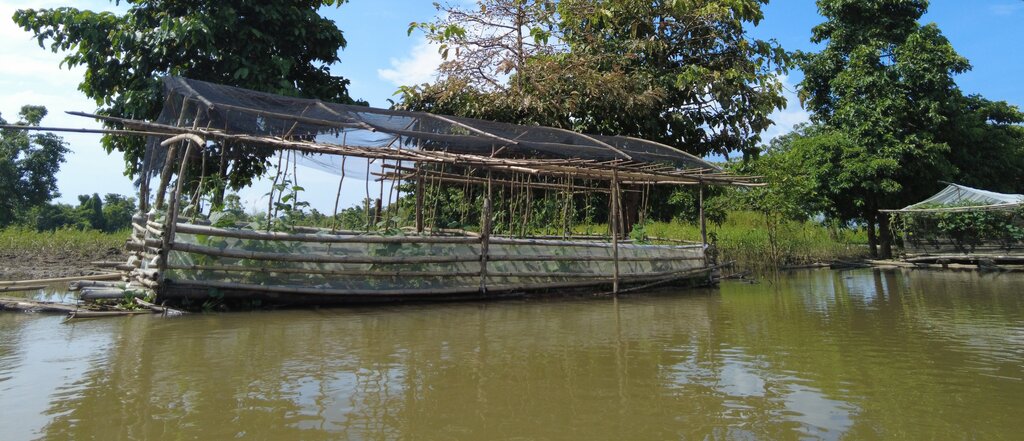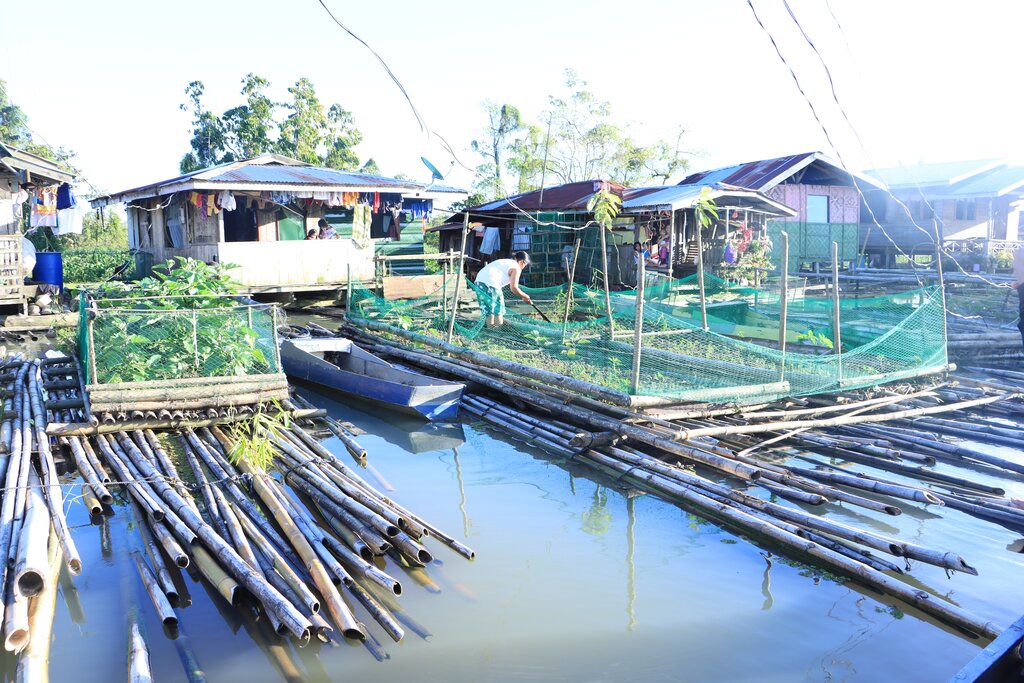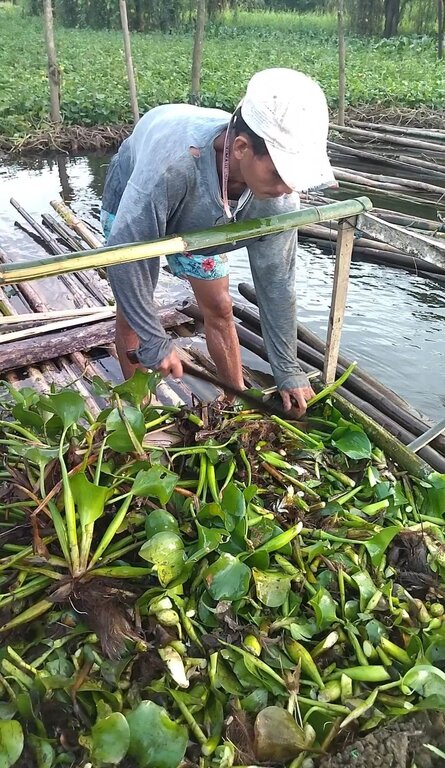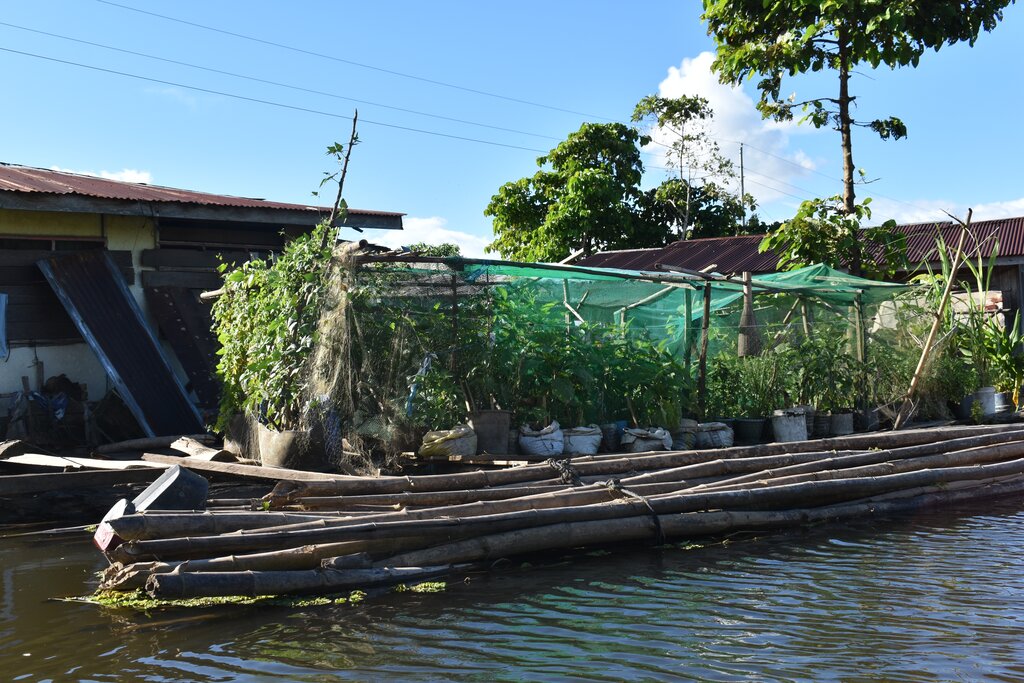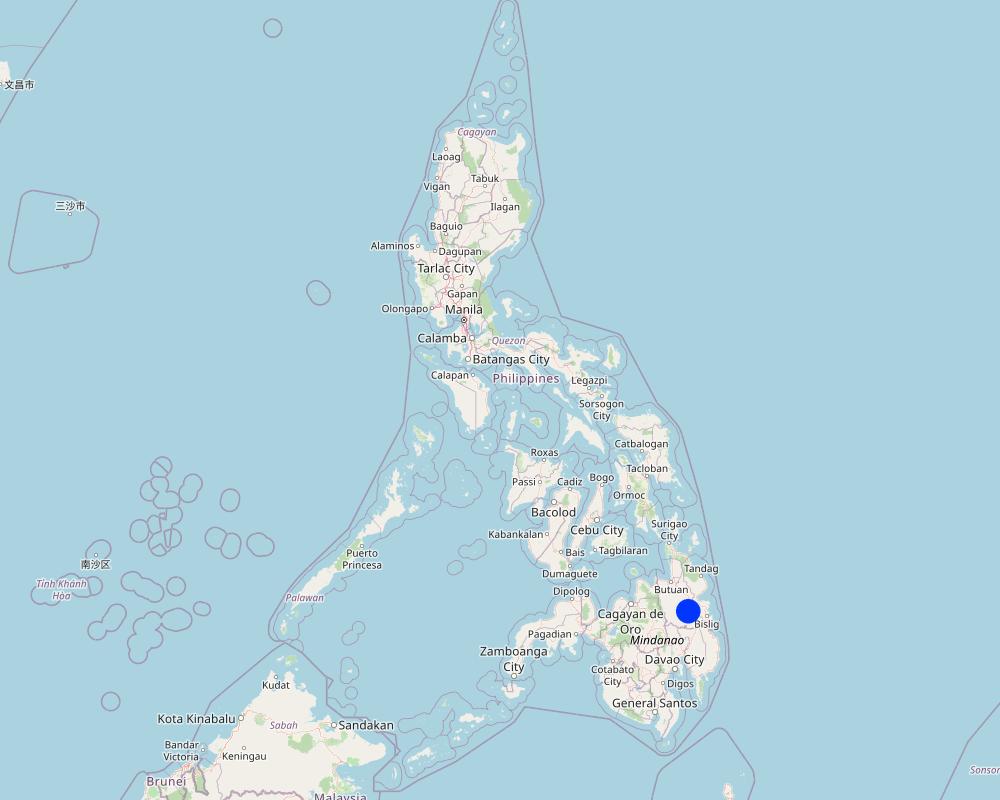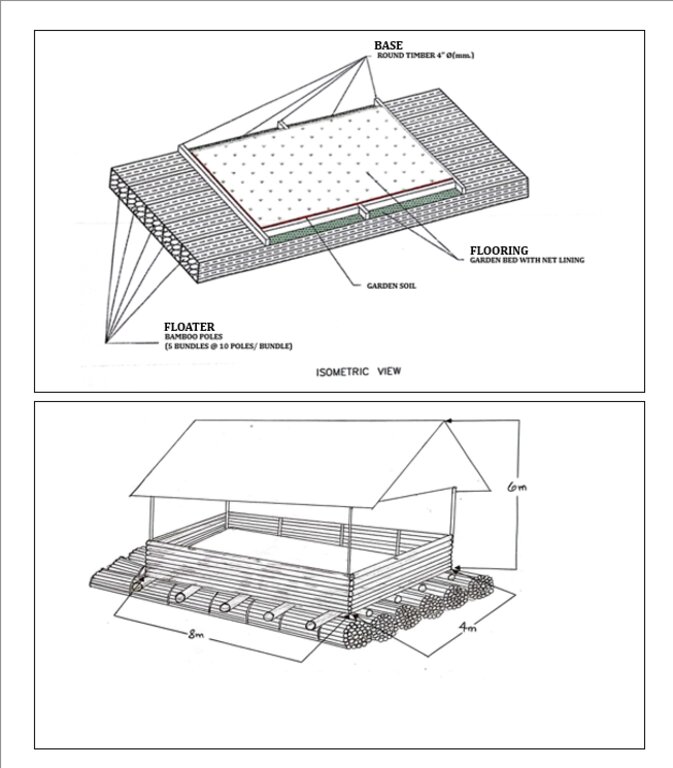Floating Vegetable Garden Using Water Hyacinth as Planting Medium [Filipinas]
- Criação:
- Atualização:
- Compilador/a: Philippine Overview of Conservation Approaches and Technologies
- Editor: –
- Revisor: Rima Mekdaschi Studer
Gulayan sa Gakit
technologies_7000 - Filipinas
Veja as seções
Expandir tudo Recolher tudo1. Informação geral
1.2 Detalhes do contato das pessoas capacitadas e instituições envolvidas na avaliação e documentação da tecnologia
Pessoa(s) capacitada(s)
usuário de terra:
Perez Mercy
Barangay Sabang Gibong, Talacogon, Agusan del Sur
Filipinas
usuário de terra:
Cutao Arnel
Barangay Sabang Gibong, Talacogon, Agusan del Sur
Filipinas
usuário de terra:
Osigan Marvin
Barangay Sabang Gibong, Talacogon, Agusan del Sur
Filipinas
Project Implementer:
Acopiado Ma. Angelita Salome
Agusan del Sur Provincial Environment and Natural Resources Office (PENRO)
Filipinas
Project Implementer:
Dumaguit Dennis
LGU of Talacogon, Agusan del Sur
Filipinas
Project Implementer:
Asufre Gemma
Department of Agriculture CARAGA
Filipinas
Project Implementer:
Tabudlong Richard
Department of Agriculture CARAGA
Filipinas
co-compilador/a:
Dinamling Djolly Ma
Bureau of Soils and Water Management
Filipinas
Biodiversity Corridor Project staff who facilitated the interviews:
Plaza Marvin Emmanuel
Bureau of Soils and Water Management
Filipinas
Biodiversity Corridor Project staff who facilitated the interviews:
Talavera Ana Marie
Bureau of Soils and Water Management
Filipinas
Biodiversity Corridor Project staff who facilitated the interviews:
Manuel Paquito Jr.
Bureau of Soils and Water Management
Filipinas
Biodiversity Corridor Project staff who facilitated the interviews:
Barraca Jodel
Bureau of Soils and Water Management
Filipinas
Project Implementer:
Amante Romer
Department of Agriculture CARAGA
Filipinas
Nome do projeto que facilitou a documentação/avaliação da Tecnologia (se relevante)
Integrated Approach in Management of Major Biodiversity Corridors in the Philippines - GEF 6 Project (BD corridor)Nome da(s) instituição(ões) que facilitou(ram) a documentação/ avaliação da Tecnologia (se relevante)
Bureau of Soils and Water Management (Bureau of Soils and Water Management) - Filipinas1.3 Condições em relação ao uso da informação documentada através de WOCAT
O/a compilador/a e a(s) pessoa(s) capacitada(s) aceitam as condições relativas ao uso de dados documentados através da WOCAT:
Sim
1.4 Declaração de sustentabilidade da tecnologia descrita
A tecnologia descrita aqui é problemática em relação a degradação da terra de forma que não pode ser declarada uma tecnologia de gestão sustentável de terra?
Não
2. Descrição da tecnologia de GST
2.1 Descrição curta da tecnologia
Definição da tecnologia:
Floating vegetable garden as a climate change adaptation strategy for the indigenous communities living in the wetland of Agusan del Sur to grow vegetables during the flooding season.
2.2 Descrição detalhada da tecnologia
Descrição:
Agusan Marsh is considered one of the wetlands in the Philippines that experiences flooding all year round, and most areas are flooded, making it impossible to grow food for the communities living in the area. In order to address this issue, the construction of floating gardens were initiated by the Department of Agriculture CARAGA supported by various government agencies and Non Government Organizations (NGOs).
The floating garden technology and initiative, developed by the Foundation for the Development of Agusanons, Inc. (FDAI), was enhanced by the Department of Agriculture CARAGA and carried out by the Agricultural Program Coordinating Office (APCO) with the aim of establishing a sustainable agricultural system that promotes biodiversity and resilient farming practices. By using decomposed water hyacinth as a medium for growing crops, the technology helps mitigate its negative effects and transforms it into a valuable resource. Water hyacinths have a variety of negative impacts such as clogging waterways hampering boating and fishing, reducing local aquatic biodiversity and obstructing river flows which can aggravate flooding. The technlogy is being adopted by the Adaptation and Mitigation Initiative in Agriculture (AMIA) as a mitigation strategy against the impacts of climate change, enabling communities to better manage and adapt to climate-related risks. It also provides means for communities in flood-prone or coastal areas to engage in sustainable agri-fishery activities, ensuring food security and enhancing biodiversity and ecosystem health.
The components of the floating garden include a floater, a base (batangan), flooring (salug), growing substrate composed of layers of water hyacinth and layers of soil. Thewater hyacinths are collected from the river, chopped, and then mixed with the soil for composting before being used as a growing substrate in the floating garden. It is applied in layers as follows: composted hyacinth/soil mix, soil, composted hyacinth/ soil mix, and soil. The use of water hyacinth as substrate for the compost addresses the community’s concern about its proliferation, which causes obstruction in rivers, resulting in the destruction of boats and houses.
The standard dimension of a floating garden is 8 meters (length) by 4 meters (width), but this could be increased depending on the needs and financial capacity of the landusers. Crops planted are high-value vegetables such as pechay (pak choi), string beans, bitter gourd, tomato, bell pepper, cucumber, and eggplant, which were provided by the Department of Agriculture.
The FDAI played a pivotal role in project implementation, overseeing the construction of floating gardens and the provision of supplemental seedlings. The Binus-Ugan Farmers Association (BFA), as the recipient of the project, received 50 units of floating gardens through the Department of Agriculture's Adaptation and Mitigation Initiative in Agriculture (AMIA) Program.
Floating gardens were instrumental to the community in growing crops as their source of food and nutrients during the COVID-19 pandemic, where movement from barangay to barangay was restricted. A barangay is the smallest administrative division in the Philippines. The floating gardens became a source of income as the excess produce was sold to neighbors. The floating garden initiative did not only enhance economic conditions but also attracted local avian species, locally referred to as "pari-pari." Furthermore, it strengthened women's involvement in the community, particularly through their active participation in maintaining the gardens.
2.3 Fotos da tecnologia
2.5 País/região/locais onde a tecnologia foi aplicada e que estão cobertos nesta avaliação
País:
Filipinas
Região/Estado/Província:
Province of Agusan Del Sur
Especificação adicional de localização:
Talacogon municipality
Especifique a difusão da tecnologia:
- Aplicado em pontos específicos/concentrado numa pequena área
O(s) local(is) tecnológico(s) está(ão) localizado(s) em uma área permanentemente protegida?
Não
Comentários:
The floating garden is within the Agusan marsh which is also considered as wildlife sanctuary.
Talacogon and Bunawan where most of the floating gardens are located. Only the Talacogon floating gardens were visited but during the interview with project implementers, they mentioned that they have also constructed floating garden in Bunawan.
Map
×2.6 Data da implementação
Indique o ano de implementação:
2022
Caso o ano exato seja desconhecido, indique a data aproximada:
- menos de 10 anos atrás (recentemente)
2.7 Introdução da tecnologia
Especifique como a tecnologia foi introduzida:
- através de projetos/intervenções externas
Comentários (tipos de projeto, etc.):
The construction of floating garden at Barangay Sabang Gibong, Talacogon was funded by the Department of Agriculture in response to the needs of the community for food sources during flooding season when growing crops is not possible because the lands are submerged in water.
3. Classificação da tecnologia de GST
3.1 Principal/principais finalidade(s) da tecnologia
- Adaptar a mudanças climáticas/extremos e seus impactos
- Criar impacto econômico benéfico
- Cria impacto social benéfico
3.2 Tipo(s) atualizado(s) de uso da terra onde a tecnologia foi aplicada
Uso do solo misturado dentro da mesma unidade de terra:
Não

Vias navegáveis, corpo d'água, zonas úmidas
- Pântanos, zonas úmidas
Principais produtos/serviços:
Vegetables for own consumption and surplus is being sold
Comentários:
Floating gardens to grow vegetables are constructed in the wetlands when the area is flooded. For the past years, flooding occurred all year round.
3.3 O uso do solo mudou devido à implementação da Tecnologia?
O uso do solo mudou devido à implementação da Tecnologia?
- Não (Continuar com a pergunta 3.4)
3.4 Abastecimento de água
Abastecimento de água para a terra na qual a tecnologia é aplicada:
- Misto de precipitação natural-irrigado
Comentários:
During rainy seasons, the landusers do not water the crops since the rainwater is already sufficient. When week passed and no rains occur, the landuser will water the crops from the river.
3.5 Grupo de GST ao qual pertence a tecnologia
- Gestão/proteção de zonas úmidas
- Hortas familiares
- Redução de riscos de desastre baseada no ecossitema
3.6 Medidas de GST contendo a tecnologia

Medidas estruturais
- S9: Abrigo para plantas e animais

Medidas de gestão
- M2: Mudança de gestão/nível de intensidade
Comentários:
Floating garden structure as shelter for plants
3.7 Principais tipos de degradação da terra abordados pela tecnologia

Degradação da água
- Hs: mudança na quantidade de água de superfície
- Hp: declínio da qualidade de água de superfície
Comentários:
Year round flooding (change in surface water quantity) limited agricultural activities on the land.
This technology address the decline of surface water quality due to the eutrophication of waterbody where water hyacinth is a contributor.
3.8 Redução, prevenção ou recuperação da degradação do solo
Especifique o objetivo da tecnologia em relação a degradação da terra:
- Adaptar à degradação do solo
Comentários:
The community adapted to the state of land degradation in the area by transferring crop production from the year round flooded fields to floating gardens and using the available resource like the water hyacinth as substrate to produce compost used as substrate for plant growth
4. Especificações técnicas, implementação de atividades, entradas e custos
4.1 Desenho técnico da tecnologia
Especificações técnicas (relacionada ao desenho técnico):
The standard size for the floating garden has a length of 8 meters, width of 4 meters, and height of 6 meters. This could be decreased or increased depending on the the financial capacity and needs of the farmer. It is composed of floater, flooring, and base. The floater is made of bamboo poles (5 bundles at 10 poles/bundle). The flooring is the garden bed with net lining. The base is made up of wood that will act as the crossbeam. Plastic roofing could be added using UV plastic.
Autor:
Jodel Barraca; Paquito Jr. C. Manuel; and DA CARAGA
Data:
09/01/2024
4.2 Informação geral em relação ao cálculo de entradas e custos
Especifique como custos e entradas foram calculados:
- Por unidade de tecnologia
Especifique a unidade:
one floating garden unit
Especificar as dimensões da unidade (se for relevante):
length-8 meters; width-4meters
Outro/moeda nacional (especifique):
Pesos
Se for relevante, indique a taxa de câmbio do USD para moeda local (por exemplo, 1 USD = 79,9 Real): 1 USD =:
55,0
Indique a média salarial da mão-de-obra contratada por dia:
350 Pesos
4.3 Atividades de implantação
| Atividade | Periodicidade (estação do ano) | |
|---|---|---|
| 1. | Construction of the floating garden | All year round |
| 2. | Collection of water hyacinth | All year round |
| 3. | Composting of water hyacinth and mixing with soil | All year round |
4.4 Custos e entradas necessárias para a implantação
| Especifique a entrada | Unidade | Quantidade | Custos por unidade | Custos totais por entrada | % dos custos arcados pelos usuários da terra | |
|---|---|---|---|---|---|---|
| Mão-de-obra | Construction of the floating garden | person/day | 16,0 | 350,0 | 5600,0 | 100,0 |
| Mão-de-obra | Collection and composting of water hyacinth | person/day | 1,0 | 350,0 | 350,0 | 100,0 |
| Material vegetal | vegetable seeds | cans | 3,0 | 1500,0 | 4500,0 | |
| Material de construção | bamboo as floater | pieces | 200,0 | 40,0 | 8000,0 | |
| Material de construção | wood for crossbeam | pieces | 4,0 | 200,0 | 800,0 | |
| Material de construção | bamboo for floor joist | pieces | 10,0 | 30,0 | 300,0 | |
| Material de construção | nails | kilos | 2,0 | 80,0 | 160,0 | |
| Material de construção | wood as sidings | board feet (bd.ft) | 4,0 | 20,0 | 80,0 | |
| Material de construção | bamboo as pole | pieces | 6,0 | 50,0 | 300,0 | |
| Material de construção | rope | pieces | 16,0 | 25,0 | 400,0 | |
| Material de construção | carabao rope for anchoring the garden | meters | 20,0 | 28,0 | 560,0 | |
| Outros | UV plastic roofing | roll (12m x 5m) | 1,0 | 6000,0 | 6000,0 | 100,0 |
| Custos totais para a implantação da tecnologia | 27050,0 | |||||
| Custos totais para o estabelecimento da Tecnologia em USD | 491,82 | |||||
Se o usuário da terra arca com menos que 100% dos custos, indique quem cobre os custos remanescentes:
The cost for the construction of the floating garden was subsidized by the Department of Agriculture
Comentários:
The materials used for the construction of the floating garden was subsidized by the government. The counterpart of the land user is the labor for the construction.
4.5 Atividades recorrentes/manutenção
| Atividade | Periodicidade/frequência | |
|---|---|---|
| 1. | Change of the bamboo used as floaters | 1 to 2 years |
| 2. | Planting of vegetable seeds | All year round |
| 3. | Fertilizer application | All year round |
| 4. | Application of organic spray | All year round |
4.6 Custos e entradas necessárias pata a manutenção/atividades recorrentes (por ano)
| Especifique a entrada | Unidade | Quantidade | Custos por unidade | Custos totais por entrada | % dos custos arcados pelos usuários da terra | |
|---|---|---|---|---|---|---|
| Mão-de-obra | Maintenance of the floater | person/day | 3,0 | 350,0 | 1050,0 | 100,0 |
| Mão-de-obra | Planting of vegetable seeds | person/day | 1,0 | 350,0 | 350,0 | 100,0 |
| Mão-de-obra | Fertilizer application | person/day | 1,0 | 350,0 | 350,0 | 100,0 |
| Mão-de-obra | Organic Spray application | person/day | 1,0 | 350,0 | 350,0 | 100,0 |
| Material vegetal | seeds | cans | 3,0 | 1500,0 | 4500,0 | 50,0 |
| Fertilizantes e biocidas | Organic Fertilizer | bag | 2,0 | 500,0 | 1000,0 | 100,0 |
| Fertilizantes e biocidas | Organic spray | liter | 4,0 | 250,0 | 1000,0 | 100,0 |
| Material de construção | bamboo | pieces | 200,0 | 40,0 | 8000,0 | 100,0 |
| Custos totais para a manutenção da tecnologia | 16600,0 | |||||
| Custos totais de manutenção da Tecnologia em USD | 301,82 | |||||
Se o usuário da terra arca com menos que 100% dos custos, indique quem cobre os custos remanescentes:
The Department of Agriculture partially subsidized the seeds
4.7 Fatores mais importantes que afetam os custos
Descreva os fatores mais determinantes que afetam os custos:
Availability of bamboo in the area which is heavily used as the floater
5. Ambiente natural e humano
5.1 Clima
Precipitação pluviométrica anual
- <250 mm
- 251-500 mm
- 501-750 mm
- 751-1.000 mm
- 1.001-1.500 mm
- 1.501-2.000 mm
- 2.001-3.000 mm
- 3.001-4.000 mm
- > 4.000 mm
Zona agroclimática
- úmido
5.2 Topografia
Declividade média:
- Plano (0-2%)
- Suave ondulado (3-5%)
- Ondulado (6-10%)
- Moderadamente ondulado (11-15%)
- Forte ondulado (16-30%)
- Montanhoso (31-60%)
- Escarpado (>60%)
Formas de relevo:
- Planalto/planície
- Cumes
- Encosta de serra
- Encosta de morro
- Sopés
- Fundos de vale
Zona de altitude:
- 0-100 m s.n.m.
- 101-500 m s.n.m.
- 501-1.000 m s.n.m.
- 1.001-1.500 m s.n.m.
- 1.501-2.000 m s.n.m.
- 2.001-2.500 m s.n.m.
- 2.501-3.000 m s.n.m.
- 3.001-4.000 m s.n.m.
- > 4.000 m s.n.m.
Indique se a tecnologia é aplicada especificamente em:
- Não relevante
5.3 Solos
Profundidade do solo em média:
- Muito raso (0-20 cm)
- Raso (21-50 cm)
- Moderadamente profundo (51-80 cm)
- Profundo (81-120 cm)
- Muito profundo (>120 cm)
Textura do solo (solo superficial):
- Fino/pesado (argila)
Textura do solo (>20 cm abaixo da superfície):
- Fino/pesado (argila)
Matéria orgânica do solo superficial:
- Médio (1-3%)
5.4 Disponibilidade e qualidade de água
Lençol freático:
Na superfície
Disponibilidade de água de superfície:
Excesso
Qualidade da água (não tratada):
Inutilizável
A qualidade da água refere-se a:
tanto de águas subterrâneas quanto de superfície
A salinidade da água é um problema?
Não
Ocorre inundação da área?
Sim
Regularidade:
Frequentemente
Comentários e outras especificações sobre a qualidade e a quantidade da água:
For the past three (3) years, the community has observed that flooding is all year round
5.5 Biodiversidade
Diversidade de espécies:
- Alto
Diversidade de habitat:
- Alto
5.6 Características dos usuários da terra que utilizam a tecnologia
Outros (especificar):
Houses are built with floaters which could be moved depending on the occurrence of floods
Orientação de mercado do sistema de produção:
- misto (subsistência/comercial)
Rendimento não agrícola:
- >50% de toda renda
Nível relativo de riqueza:
- Pobre
Indivíduos ou grupos:
- Indivíduo/unidade familiar
- Grupos/comunidade
Nível de mecanização:
- Trabalho manual
Gênero:
- Mulheres
- Homens
Idade dos usuários da terra:
- meia-idade
- idosos
Indique outras características relevantes dos usuários da terra:
Fishing is the main source of income of the landusers
5.7 Área média de terrenos utilizados pelos usuários de terrenos que aplicam a Tecnologia
- < 0,5 ha
- 0,5-1 ha
- 1-2 ha
- 2-5 ha
- 5-15 ha
- 15-50 ha
- 50-100 ha
- 100-500 ha
- 500-1.000 ha
- 1.000-10.000 ha
- > 10.000 ha
É considerado pequena, média ou grande escala (referente ao contexto local)?
- Pequena escala
Comentários:
Less than 0.5 ha refers to the size of the floating garden itself
5.8 Propriedade de terra, direitos de uso da terra e de uso da água
Propriedade da terra:
- Comunitário/rural
Direitos do uso da terra:
- Comunitário (organizado)
Direitos do uso da água:
- Comunitário (organizado)
Os direitos de uso da terra são baseados em um sistema jurídico tradicional?
Sim
Comentários:
General characteristics of the situation in the area where the floating gardens are being implemented
5.9 Acesso a serviços e infraestrutura
Saúde:
- Pobre
- Moderado
- Bom
Educação:
- Pobre
- Moderado
- Bom
Assistência técnica:
- Pobre
- Moderado
- Bom
Emprego (p. ex. não agrícola):
- Pobre
- Moderado
- Bom
Mercados:
- Pobre
- Moderado
- Bom
Energia:
- Pobre
- Moderado
- Bom
Vias e transporte:
- Pobre
- Moderado
- Bom
Água potável e saneamento:
- Pobre
- Moderado
- Bom
Serviços financeiros:
- Pobre
- Moderado
- Bom
6. Impactos e declarações finais
6.1 Impactos no local mostrados pela tecnologia
Impactos socioeconômicos
Produção
Produção agrícola
Comentários/especificar:
There is an increase in production since floating garden made it possible for the landusers to grow crops in the absence of productive land for cultivation
Diversidade de produtos
Comentários/especificar:
The landusers planted other vegetables which were given by the Department of Agriculture.
Área de produção
Comentários/especificar:
The production area increased since they could also produce using the floating garden.
Renda e custos
Diversidade de fontes de rendimento
Comentários/especificar:
The landuser will not only rely on fishing as source of income but also on vegetable production
Impactos socioculturais
Segurança alimentar/auto-suficiência
Comentários/especificar:
The community does not need to go to the mainland or to the town market to buy vegetables since they could grow their own produce.
Oportunidades culturais
Comentários/especificar:
Women's involvement in the community, particularly through their active participation in maintaining the gardens
Conhecimento de GST/ degradação da terra
Comentários/especificar:
Trainings were conducted by the Department of Agriculture on Sustainable Land Management (SLM) and vegetable production
Situação de grupos social e economicamente desfavorecidos
Comentários/especificar:
The floating garden provided income to the indigenous people living in the area
Impactos ecológicos
Biodiversidade: vegetação, animais
Diversidade de habitat
Comentários/especificar:
Attracted local bird species, locally referred to as "pari-pari."
Controle de praga/doença
Comentários/especificar:
Utilized water hyacinth which is considered as an invasive aquatic weed
Clima e redução de riscos de desastre
Emissão de carbono e gases de efeito estufa
6.2 Impactos externos mostrados pela tecnologia
Poluição de água subterrânea/rio
Comentários/especificar:
The establishment of the floating gardens reduced the invasive population of the water hyacinth in the Agusan Marsh.
6.3 Exposição e sensibilidade da tecnologia às mudanças climáticas graduais e extremos/desastres relacionados ao clima (conforme o ponto de vista dos usuários da terra)
Mudança climática gradual
Mudança climática gradual
| Estação do ano | aumento ou diminuição | Como a tecnologia lida com isso? | |
|---|---|---|---|
| Precipitação pluviométrica anual | aumento | bem |
Extremos (desastres) relacionados ao clima
Desastres meteorológicos
| Como a tecnologia lida com isso? | |
|---|---|
| Tempestade tropical | moderadamente |
| Temporal local | muito bem |
Desastres hidrológicos
| Como a tecnologia lida com isso? | |
|---|---|
| Inundação geral (rio) | muito bem |
| Inundação súbita | não bem |
6.4 Análise do custo-benefício
Como os benefícios se comparam aos custos de implantação (do ponto de vista dos usuários da terra)?
Retornos a curto prazo:
negativo
Retornos a longo prazo:
positivo
Como os benefícios se comparam aos custos recorrentes/de manutenção(do ponto de vista dos usuários da terra)?
Retornos a curto prazo:
positivo
Retornos a longo prazo:
positivo
6.5 Adoção da tecnologia
- > 50%
De todos aqueles que adotaram a Tecnologia, quantos o fizeram espontaneamente, ou seja, sem receber nenhum incentivo/ pagamento material?
- 0-10%
6.6 Adaptação
A tecnologia foi recentemente modificada para adaptar-se as condições variáveis?
Não
6.7 Pontos fortes/vantagens/oportunidades da tecnologia
| Pontos fortes/vantagens/oportunidades na visão do usuário da terra |
|---|
| Serves as an efficient mode of resource utilization on a small productive land area like the Agusan Marsh. |
| Relatively sustainable use of environmental resources. |
| An additional source of sustenance/income from the floating garden's produce. |
| Pontos fortes/vantagens/oportunidades na visão do/a compilador/a ou de outra pessoa capacitada |
|---|
| The floating garden technology could act as an additional tourist spot in Agusan Marsh. |
| There is strong support from various stakeholders, including the Municipal and Provincial Local Government Units, Department of Agriculture and Department of Environment and Natural Resources (DENR) |
| Promote greater engagement within the community. |
| Reduce eutrophication by recycling water hyacinth |
6.8 Pontos fracos, desvantagens/riscos da tecnologia e formas de superá-los
| Pontos fracos/desvantagens/riscos na visão do usuário da terra | Como eles podem ser superados? |
|---|---|
| Initial capital cost can be a hindrance for the community in Agusan Marsh. | The floating garden could be a project of the Local Government Unit (LGU) where they can subsidize the initial costs. |
| Pontos fracos/vantagens/riscos na visão do/a compilador/a ou de outra pessoa capacitada | Como eles podem ser superados? |
|---|---|
| Erosion on river banks due to bamboo utilization for the construction of the floating garden. (Lack of resource sustainability program). | The community can initiate a bamboo planting program to ensure the sustainability of bamboo production and prevent soil erosion in riverbanks. |
| Some of the floating gardens constructed sunk because of the incorrect proportion of soil and compost ratio | Close monitoring during the land preparation to ensure the stability of floating garden. |
| Lack of monitoring of the technology by concerned government agencies due to the difficult accessibility of the community where the technology is being practiced. It will take three hours using pump boat to reach the barangay. | Government agency involved to look for possible source of funding for procurement of pump boats to be used for monitoring. The Department of Agriculture could train people from the barangay on how to do the monitoring and take measurements. |
7. Referências e links
7.1 Métodos/fontes de informação
- visitas de campo, pesquisas de campo
Number of field visits: 2
- entrevistas com usuários de terras
Number of informants: 8
Quando os dados foram compilados (no campo)?
10/12/2024
7.2 Referências às publicações disponíveis
Título, autor, ano, ISBN:
Design, User, Experience, and Usability; Aaron Marcus, Elizabeth Rosenzweig, and Marcelo M. Soares (Eds.); 2023; ISBN: 978-3-031-35704-6
Disponível de onde? Custos?
Google Books; Free of charge
7.3 Links para informações on-line relevantes
Título/ descrição:
Residents build flood-resilient floating gardens in Agusan Marsh
URL:
https://www.mindanews.com/top-stories/2021/07/residents-build-flood-resilient-floating-gardens-in-agusan-marsh/?fbclid=IwAR2PNh3GmiUKpk8JTWw5kHjcTRz4opsPxJGlWmvzjU33BWyHNR9jUb5ipnw
Título/ descrição:
Feature: Vegetable Garden floats in Agusan Marsh
URL:
https://issuu.com/caragainfocus/docs/october_15-21_2022/s/17258517?fbclid=IwAR0tLILkV0qGVCkcLJbMWcn5bAgBKJqxp4bfKKPzXDBBm9Zd3MmQTMlG0Wg
7.4 Comentários gerais
The questionnaire, though it's lengthy, has all the relevant information that the interviewee must determine from the site. This incites a comprehensive documentation process, ensuring that all the subject's technology and adjacent information (i.e. community and environmental impacts) are captured.
Links e módulos
Expandir tudo Recolher tudoLinks
Não há links
Módulos
Não há módulos


